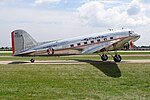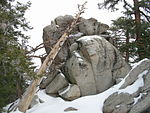Palm Springs Aerial Tramway
1963 establishments in CaliforniaAerial tramways in the United StatesAlbert Frey buildingsBuildings and structures in Palm Springs, CaliforniaE. Stewart Williams buildings ... and 9 more
Geographic coordinate listsLists of coordinatesModernist architecture in CaliforniaSan Jacinto MountainsTourist attractions in Palm Springs, CaliforniaTransport infrastructure completed in 1963Transport infrastructure completed in 2000Transportation buildings and structures in CaliforniaTransportation buildings and structures in Riverside County, California

The Palm Springs Aerial Tramway in Palm Springs, California, is the largest rotating aerial tramway in the world. It was opened in September 1963 as a way of getting from the floor of the Coachella Valley to near the top of San Jacinto Peak and was constructed in rugged Chino Canyon. Before its construction, the only way to the top of the mountain was to hike hours from Idyllwild. The rotating cars were added in 2000.
Excerpt from the Wikipedia article Palm Springs Aerial Tramway (License: CC BY-SA 3.0, Authors, Images).Palm Springs Aerial Tramway
Tramway Road, Palm Springs
Geographical coordinates (GPS) Address Website Nearby Places Show on map
Geographical coordinates (GPS)
| Latitude | Longitude |
|---|---|
| N 33.8372 ° | E -116.6142 ° |
Address
Palm Springs Aerial Tramway
Tramway Road
Palm Springs
California, United States
Open on Google Maps









